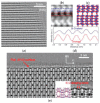The Development of iDPC-STEM and Its Application in Electron Beam Sensitive Materials
- PMID: 35744947
- PMCID: PMC9231126
- DOI: 10.3390/molecules27123829
The Development of iDPC-STEM and Its Application in Electron Beam Sensitive Materials
Abstract
The main aspects of material research: material synthesis, material structure, and material properties, are interrelated. Acquiring atomic structure information of electron beam sensitive materials by electron microscope, such as porous zeolites, organic-inorganic hybrid perovskites, metal-organic frameworks, is an important and challenging task. The difficulties in characterization of the structures will inevitably limit the optimization of their synthesis methods and further improve their performance. The emergence of integrated differential phase contrast scanning transmission electron microscopy (iDPC-STEM), a STEM characterization technique capable of obtaining images with high signal-to-noise ratio under lower doses, has made great breakthroughs in the atomic structure characterization of these materials. This article reviews the developments and applications of iDPC-STEM in electron beam sensitive materials, and provides an outlook on its capabilities and development.
Keywords: electron beam sensitive materials; electron microscopic characterization; iDPC-STEM; low dose.
Conflict of interest statement
The authors declare no conflict of interest.
Figures

























Similar articles
-
Imaging biological samples by integrated differential phase contrast (iDPC) STEM technique.J Struct Biol. 2022 Mar;214(1):107837. doi: 10.1016/j.jsb.2022.107837. Epub 2022 Jan 31. J Struct Biol. 2022. PMID: 35104612
-
Atomic Spatial and Temporal Imaging of Local Structures and Light Elements inside Zeolite Frameworks.Adv Mater. 2020 Jan;32(4):e1906103. doi: 10.1002/adma.201906103. Epub 2019 Nov 29. Adv Mater. 2020. PMID: 31782558
-
Optimizing experimental parameters of integrated differential phase contrast (iDPC) for atomic resolution imaging.Ultramicroscopy. 2023 Apr;246:113686. doi: 10.1016/j.ultramic.2023.113686. Epub 2023 Jan 18. Ultramicroscopy. 2023. PMID: 36682324
-
Imaging Beam-Sensitive Materials by Electron Microscopy.Adv Mater. 2020 Apr;32(16):e1907619. doi: 10.1002/adma.201907619. Epub 2020 Feb 28. Adv Mater. 2020. PMID: 32108394 Review.
-
4D-STEM Ptychography for Electron-Beam-Sensitive Materials.ACS Cent Sci. 2022 Dec 28;8(12):1579-1588. doi: 10.1021/acscentsci.2c01137. Epub 2022 Nov 21. ACS Cent Sci. 2022. PMID: 36589892 Free PMC article. Review.
Cited by
-
Simulation Study of Low-Dose 4D-STEM Phase Contrast Techniques at the Nanoscale in SEM.Nanomaterials (Basel). 2025 Jan 4;15(1):70. doi: 10.3390/nano15010070. Nanomaterials (Basel). 2025. PMID: 39791828 Free PMC article.
-
Low-cost electron detector for scanning electron microscope.HardwareX. 2023 Mar 10;14:e00413. doi: 10.1016/j.ohx.2023.e00413. eCollection 2023 Jun. HardwareX. 2023. PMID: 36969750 Free PMC article.
References
-
- Feyand M., Mugnaioli E., Vermoortele F., Bueken B., Dieterich J.M., Reimer T., Kolb U., De Vos D., Stock N. Automated Diffraction Tomography for the Structure Elucidation of Twinned, Sub-micrometer Crystals of a Highly Porous, Catalytically Active Bismuth Metal-Organic Framework. Angew. Chem. Int. Ed. 2012;51:10373–10376. doi: 10.1002/anie.201204963. - DOI - PubMed
-
- Yakovenko A.A., Reibenspies J.H., Bhuvanesh N., Zhou H.C. Generation and applications of structure envelopes for porous metal–Organic frameworks. J. Appl. Crystallogr. 2013;46:346–353. doi: 10.1107/S0021889812050935. - DOI
-
- Song Q., Nataraj S.K., Roussenova M.V., Tan J.C., Hughes D.J., Li W., Sivaniah E. Zeolitic imidazolate framework (ZIF-8) based polymer nanocomposite membranes for gas separation. Energy Environ. Sci. 2012;5:8359–8369. doi: 10.1039/c2ee21996d. - DOI
Publication types
MeSH terms
Grants and funding
LinkOut - more resources
Full Text Sources

